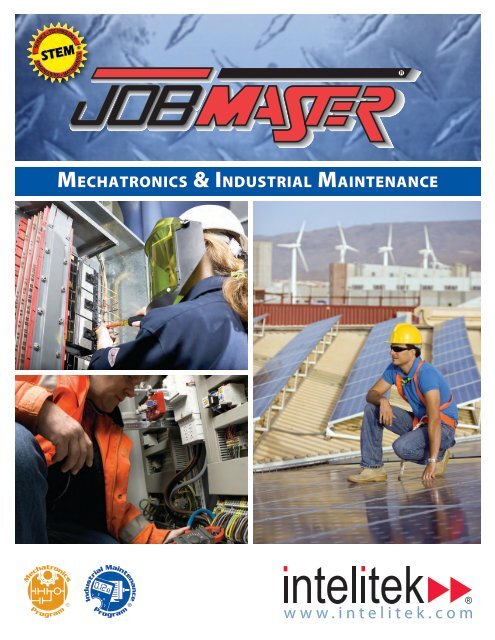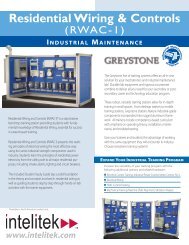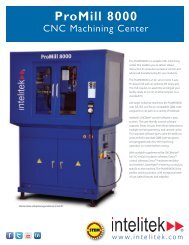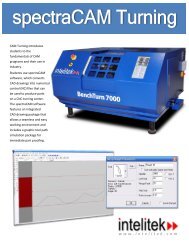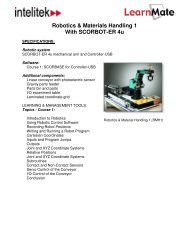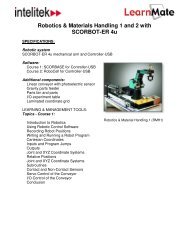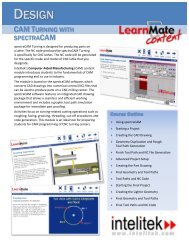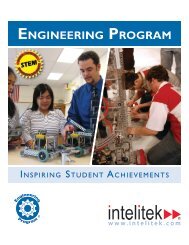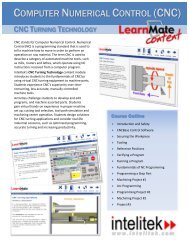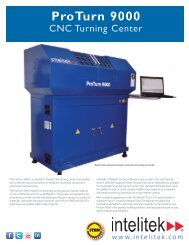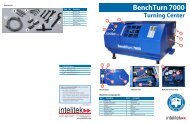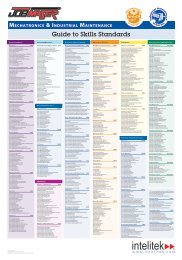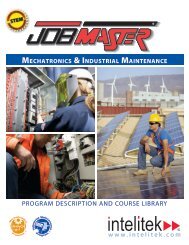www.intelitek.com
www.intelitek.com
www.intelitek.com
You also want an ePaper? Increase the reach of your titles
YUMPU automatically turns print PDFs into web optimized ePapers that Google loves.
Mechatronics & Industrial Maintenance<br />
w w w . i n t e l i t e k . c o m
Validated by Industry . . .<br />
The JobMaster® Training Program<br />
Industrial Manufacturing. Green Technology. New and Emerging Industries.<br />
Employers in all sectors, from traditional manufacturing to emerging<br />
industries, need qualified workers to meet the increasing demands of a<br />
changing world. Advancing technologies and global <strong>com</strong>petition put<br />
new demands on the workforce. The shortage of qualified workers<br />
is felt whether searching for highly-skilled candidates or entry-level<br />
candidates with basic skills.<br />
The JobMaster® Training programs provides an effective solution to<br />
this critical need. JobMaster® training delivers the critical skills needed<br />
by industries of all sectors, and for trainees of all types. Whether<br />
implemented in high school and <strong>com</strong>munity college programs, or in<br />
industrial training programs to equip existing employees with new<br />
skills, JobMaster® provides a scalable training program custom-fit to<br />
your needs.<br />
With a <strong>com</strong>prehensive skill list developed in tangent with many<br />
industries, students obtain skills that will serve in careers today and well<br />
into the future.<br />
A Critical Moment Gives Birth to a Program Delivering Critical Skills<br />
The 1979 accident at the Three Mile Island nuclear power plant<br />
in Pennsylvania was the most serious in U.S. <strong>com</strong>mercial nuclear<br />
power plant operating history. Though no one was injured or<br />
killed, it brought about sweeping changes to many areas of nuclear<br />
power plant operations, including reactor operator training.<br />
To implement these new policies, teams of industrial engineers<br />
from Technical Resource Group, the parent <strong>com</strong>pany of JobMaster®,<br />
created detailed job task analyses on every task necessary for plant<br />
operation. A sophisticated algorithm was developed to measure<br />
the safety risk, difficulty level, frequency, and time spent for each<br />
technical task. The results were used to define training programs<br />
and assessment for plant operators and successfully implemented<br />
at nuclear power plants around the country.<br />
JobMaster® covers the following topics<br />
• Basic Foundation Skills<br />
• Precision Measurement<br />
• Basic Power Electricity<br />
• Electrical Control Systems<br />
• Industrial Power Electronics<br />
• Mechanical Systems<br />
• Hydraulics<br />
• Pneumatics<br />
• Electromechanical Maintenance Cell Capstone Project<br />
• and more!<br />
2 info@<strong>intelitek</strong>.<strong>com</strong><br />
With that success, the <strong>com</strong>pany offered these same benefits<br />
to the industrial market. The same Job Task Analysis was used<br />
to implement industrial training programs for Fortune 1000<br />
<strong>com</strong>panies such as:<br />
• Caterpillar<br />
• DuPont<br />
• General Electric<br />
• General Motors<br />
• Ford<br />
• U.S. Steel<br />
Today, JobMaster® has documented and developed programs<br />
for over 50,000 specific skills. This same <strong>com</strong>bination of skill<br />
requirements validated and funded by industry forms the<br />
JobMaster® Mechatronics and Industrial Maintenance program.<br />
Now JobMaster® is supercharged with <strong>intelitek</strong>’s LearnMate®<br />
online E-learning technology. This enables online delivery, student<br />
tracking, reporting, valid assessment and certification, making<br />
JobMaster® an industrial maintenance program unlike any other!
. . . powered by LearnMate®<br />
JobMaster® is powered by LearnMate®, <strong>intelitek</strong>’s flagship blended<br />
learning solution. This online Learning Management System (LMS) is<br />
successfully deployed in over 500 LearnMate® labs worldwide. Developed<br />
to meet the specific needs of technical classrooms, LearnMate® puts<br />
powerful content delivery and classroom management capabilities into<br />
the hands of instructors.<br />
p o w e r e d b y<br />
LearnMate® enables your industrial training to be accessible, flexible and<br />
measurable. Easily enroll users, set up groups and permission levels, track<br />
progress and deliver online assessments. Import any set of <strong>com</strong>petencies<br />
or create your own and map these <strong>com</strong>petencies to the activities.<br />
Produce robust custom reports to document and validate what your<br />
program is ac<strong>com</strong>plishing as measured against these standards.<br />
Students can access content anytime, anywhere, and proceed at their<br />
own individualized pace. Robust simulations, interactive animations<br />
and videos - all correlated to the JobMaster® training hardware - ensure<br />
relevant instruction keeps trainees engaged. Tests and quizzes with<br />
multiple question types identify skills gaps for focused training.<br />
With over 2,500 hours of content in Automated Manufacturing, Computer-<br />
Assisted Design (CAD), Computer-Assisted Machining (CAM), Computer<br />
Numerical Control (CNC), Robotics, Flexible Manufacturing Systems (FMS)<br />
Computer Integrated Manufacturing (CIM) and more, LearnMate® offers a<br />
<strong>com</strong>plete solution to your mechatronics training needs.<br />
LEARNMATE® IS THE DASHBOARD TO YOUR TRAINING PROGRAM,<br />
PUTTING POWERFUL ADMINISTRATIVE FEATURES AT YOUR FINGERTIPS.<br />
• Curriculum delivery<br />
• Deliver consistent content across multiple organizations<br />
• Compatible with ANY SCORM (Sharable Content Object<br />
Reference Model)-<strong>com</strong>pliant content<br />
• AICC (Aviation Industry CBT [Computer-Based Training]<br />
Committee)-<strong>com</strong>pliant<br />
• Content authoring with LearnMate® Author<br />
• Create your own SCORM-<strong>com</strong>pliant, AICC-<strong>com</strong>pliant, 508c<br />
capable curriculum, tests and assignments<br />
• Easy-to-use classroom management<br />
• Quickly and easily set up users, groups and permissions<br />
• Track student and class progress<br />
• Create student portfolios and certifications<br />
• Produce customizable multi-level reports<br />
• Standards and <strong>com</strong>petency mapping<br />
• Map program and student performance to any set of<br />
standards - even organization-specific <strong>com</strong>petencies<br />
you create<br />
• Secure assessments<br />
• Create, deliver and track <strong>com</strong>puter-based assessments<br />
• Evaluate student progress<br />
• Establish any portion of content as an assessment<br />
• Pinpoint skills gaps<br />
• Certifications and scalable accountability<br />
• Track data on student out<strong>com</strong>es, <strong>com</strong>petencies, and learning<br />
gaps at multiple levels<br />
• Provide a valid record of achievements with certifications<br />
• Online learning <strong>com</strong>munity<br />
• Provide a dynamic environment for learning, including<br />
forums, real-time chat and e-mail<br />
• Students can engage in group discussions and projects and<br />
interact with instructors<br />
• Instructors can post assignments, create daily topics, get<br />
instant feedback from students<br />
• Share resources and collaborate<br />
(800) 221-2763<br />
3
Modular Hardware & Relevant Content . . .<br />
JobMaster® provides a superior blended learning solution<br />
for mechatronics and industrial maintenance training by<br />
<strong>com</strong>bining industrial-grade <strong>com</strong>ponents<br />
with engaging e-learning content.<br />
No other training system provides exposure to industry-standard practices like<br />
JobMaster®. The three hardware platforms <strong>com</strong>prising the JobMaster® system -<br />
the modular JobMaster® Learning Station, the Mechanical Training Bench, and<br />
the 1600 Electromechanical Maintenance Cell - consist of industry standard<br />
<strong>com</strong>ponents:<br />
• All JobMaster® curriculum is skill-based, developed by industry experts from<br />
Fortune 1000 <strong>com</strong>panies across a wide range of sectors.<br />
• All <strong>com</strong>ponents are the same as used in industry, from VFDs to solar-voltaic cells.<br />
• All wiring is terminated with crimped ferrules, like those found in industry.<br />
• The JobMaster® learning station includes frame-mounted industry-standard<br />
conduit, allowing students to learn effective wiring practices when wiring<br />
from panel to panel.<br />
JOBMASTER® MOBILE LEARNING STATION<br />
The ultimate flexibility in skills training<br />
JobMaster® Learning Station<br />
The JobMaster® Two-Sided Mobile Learning<br />
Station is the hardware foundation of the<br />
JobMaster® Electrical Training Courses.<br />
This sturdy anodized aluminum learning<br />
station provides the mounting points for<br />
the Flexponent panels provided with the<br />
JobMaster® courses.<br />
Each side of the learning station can hold 15<br />
standard Flexponent panels and ac<strong>com</strong>modates<br />
two students. Students can quickly and<br />
easily mount and remove panels to configure<br />
their work area for each individual skill.<br />
The versatile learning station facilitates classroom<br />
organization. Lockable swiveling casters and the<br />
32” (81 cm) depth enables easy mobility through standard facility doorways. For<br />
additional panel storage a Portable Storage Unit is available, which holds up<br />
to 50 standard JobMaster® panels.<br />
JOBMASTER® MECHANICAL TRAINING BENCH<br />
All-in-one solution for mechanical training<br />
The JobMaster® Mechanical Systems mobile training station presents<br />
the operating principles of power transmission using the same<br />
industrial-strength <strong>com</strong>ponents used in factory environments.<br />
Guided by skill-based e-learning curriculum, students work with basic<br />
machines, machine statics and dynamics, shafts and keys, bearings,<br />
belt drives, chain drives, speed reducers, electric brakes and gear drives.<br />
Optional add-ons include vibration analysis and laser alignment.<br />
With the optional two-student add-on, the mechanical training bench<br />
can ac<strong>com</strong>modate a total of four students.<br />
JobMaster® FlexPonent Panels<br />
Once you have<br />
equipped your program<br />
with the appropriate<br />
learning stations to<br />
ac<strong>com</strong>modate your<br />
students, simply choose<br />
the courses that cover<br />
the skills and concepts<br />
needed in your training<br />
program.<br />
In addition to content,<br />
each JobMaster® series of courses includes all the necessary FlexPonent<br />
panels for use on the learning station, along with any additional tools and<br />
hardware used in the skill-based activities, such as meters and scopes.<br />
All Flexponent panels are constructed of non-conductive, high density<br />
polyethylene with industry-standard recessed and insulated terminal strip<br />
connections.<br />
Mechanical Systems<br />
4 info@<strong>intelitek</strong>.<strong>com</strong>
. . . Components of a Solid Training Program<br />
THE JOBMASTER® 1600 ELECTROMECHANICAL<br />
MAINTENANCE CELL - CAPSTONE PROJECT<br />
Industrial training tour-de-force.<br />
The JobMaster® 1600 Electromechanical Maintenance Cell is<br />
the ultimate capstone to any industrial maintenance or mechatronics<br />
program. The Maintenance Cell provides a relevant and robust<br />
simulation of the workplace and valid delivery of career skills. Students<br />
assemble, wire, maintain, and troubleshoot electromechanical systems<br />
just as if they were in the industrial environment. This results in the most<br />
effective authentic assessment of a trainees ability to succeed in the<br />
field of mechatronics or industrial maintenance.<br />
In a footprint of 60 square feet (5.6 square meters), the Maintenance Cell<br />
includes electrical power distribution and controls, wire and cable tray,<br />
wireways, conduit and equipment housings. Add-on sub-systems include<br />
conveyor drives and controls, industrial lighting, three-phase motor<br />
controls, pneumatics, DC motor drives and variable frequency drives.<br />
Using industry-standard work orders, standard operating procedures,<br />
schematic diagrams and manufacturers technical manuals as resources,<br />
students assemble and wire the Maintenance Cell. Once constructed,<br />
instructors can remotely insert over 130 documented faults in the<br />
system for trainees to develop troubleshooting skills in a relevant,<br />
engaging manner. Each task includes validated industry standards<br />
providing measurable criteria for assessing students’ performance.<br />
Electromechanical Maintenance Cell<br />
“The 1600 is the ultimate test for students. Any students that can<br />
assemble and troubleshoot the JobMaster® 1600 cell as part of a<br />
team would be prime candidates for employment.”<br />
Plant Supervisor, BAE Systems<br />
SKILL-BASED E-LEARNING CONTENT<br />
Core concepts are taught through self-paced e-learning<br />
curriculum. Each course teaches fundamental concepts and<br />
reinforces concepts by guiding students through skill-based<br />
activities using the JobMaster® hardware.<br />
All the necessary resources, including printable instructions<br />
and wiring diagrams are available online, ready for use at the<br />
JobMaster® Learning Station.<br />
Instructors are also provided <strong>com</strong>prehensive resources,<br />
including a detailed instructors’ guide. Teachers’ versions of<br />
schematics as well as tips and tricks are all one click away.<br />
FOUNDATION SKILLS COURSES<br />
Success in today’s workforce requires more than just technical skills. Intelitek’s Foundation<br />
Skills courses provide job ready skills for lifelong success..<br />
Add Foundation courses to your JobMaster® program to deliver essential skills for success in the workforce!<br />
Foundation Skills courses deliver vital skills for technical careers, including blue print reading, applications of hand and<br />
power tools and safety. Foundations courses also focus on 21st Century skills like critical thinking, problem solving<br />
and collaboration. By including 21st Century skills education, learners obtain <strong>com</strong>munication skills, work ethics and<br />
career focus that lead to personal growth and success in the work environment.<br />
The Foundation Skills Program makes an excellent add-on to industrial training programs.<br />
• Foundations courses are 100% virtual on-line courses, accessible anywhere, anytime.<br />
• Some courses have optional hardware available<br />
Foundations courses include:<br />
• Employability<br />
• Industrial Safety: Lockout/Tagout<br />
• Mathematics for Technicians 1 & 2<br />
• Blueprint Reading<br />
• Hand Tools & Power Tools<br />
• Mechanical Fasteners<br />
• Lubrication for Technicians<br />
• Mechanical Measurement and <br />
Quality Control<br />
• and more!<br />
(800) 221-2763 5
Certified & Qualified . . .<br />
Funded and validated by industry, the JobMaster® Program is an industrial standard. JobMaster® Certification<br />
measures the students skills against specific tasks. JobMaster® certifications provide trainees validation of the<br />
specific skills they possess, enabling employers to evaluate new candidates and measure training programs.<br />
Maintenance Technician - Level I<br />
Maintenance Technician - Level II<br />
Maintenance Technician - Level III<br />
Foundation Skills<br />
Employability (3097)<br />
Introduction to Advanced Manufacturing (3096)<br />
Industrial Safety - Lockout/Tagout (LOTO)<br />
Mathematics for Technicians I (BA01A)<br />
Mathematics for Technicians II (BA01B)<br />
Blueprint Reading (BA02)<br />
Lubrication for Technicians (BA03)<br />
Mechanical Fasteners (BA04)<br />
Hand Tools (BA05)<br />
Power Tools (BA06)<br />
Precision Measurement<br />
Precision Measurement & Quality Control (8014)<br />
Mechanical Systems<br />
Basic Mechanical Drive Components (ME01)<br />
Machine Statics & Dynamics (ME02)<br />
Machine Shafts & Keys (ME03)<br />
Bearings (ME04)<br />
Belt Drives (ME05)<br />
Chain Drives (ME06)<br />
Machine Shaft Couplings (ME07)<br />
Machine Gear Drives (ME08)<br />
Speed Reducers (ME09)<br />
Electric Brakes (ME10)<br />
Basic Power Electricity<br />
Electrical Circuits (EA01A)<br />
Resistors & Conductors (EA01B)<br />
LCR Circuits (EA01C)<br />
Motors & Generators (EA01D)<br />
Pneumatics<br />
Pneumatics 1: Fundamentals (8068)<br />
Hydraulics<br />
Hydraulics 1: Fundamentals (8008)<br />
6 info@<strong>intelitek</strong>.<strong>com</strong><br />
Mechanical Systems<br />
Laser Alignment (ME11)<br />
Vibration Analysis (ME12)<br />
Bearing Maintenance (ME13)<br />
Electrical Control Systems<br />
Electric Circuit Protection & Monitoring (EA02)<br />
Transformers (EA03)<br />
Electric Motors (EA04)<br />
Electromagnetic Motor Starters (EA07)<br />
Relays, Timers, & Time Delay Relays (EA08)<br />
Pilot Devices (EA09)<br />
Solid-State Reduced Voltage Starters (EA11)<br />
Variable Frequency Drives (VFDs) (EA12)<br />
Solid-State Drive & DC Motor Control (EA16)<br />
Industrial Power Electronics<br />
Oscilloscope (EB01A)<br />
Digital Multimeter (EB01B)<br />
Hand Held Digital Oscilloscope (EB01C)<br />
DC Power Supplies (EB02A)<br />
Single-Phase & Three-Phase Power Supplies (EB02B)<br />
Thyristor Electric Motor Drives (EB03)<br />
Electronic Timers (EB04)<br />
Stepper Motor Drives (EB05)<br />
Servo Motor Drives (EB06)<br />
Pneumatics<br />
Pneumatics 2: Advanced (8069)<br />
Pneumatics 3: Electro-Pneumatics (3039)<br />
Hydraulics<br />
Hydraulics 2: Electro-Hydraulics (3025)<br />
In-Demand Green-Tech Skills!<br />
Electrical Control Systems<br />
Programmable Logic Control - MicroLogix (EA18)<br />
Programmable Logic Control -Allen-Bradley SLC 500 (EA20)<br />
Electromechanical Maintenance Cell<br />
Basic Maintenance Cell (ZA01)<br />
Conveyor, Drive & Controls (ZA02)<br />
Part Manipulation (ZA03)<br />
Industrial Lighting Circuits (ZA04)<br />
Adjustable Frequency Drive (ZA05)<br />
DC Motor Drive (ZA06)<br />
Fault Insertion System (ZA07)<br />
Demand is high for skilled workers in the green technology sector! Industries involved in<br />
harnessing renewable energy sources, conserving natural resources & reducing pollution face<br />
a shortage of qualified entry-level candidates possessing critical skills. These “in-demand” jobs<br />
include: solar photovoltaic (PV) system installers, wind-turbine technicians and<br />
clean-energy production technicians.<br />
JobMaster® certification provides the criticalskills needed to fillthis demand!
. . . for In-demand and Emerging Careers<br />
Level I Careers<br />
The Level 1 Maintenance Technician<br />
Certification serves as a strong foundation for<br />
a rewarding career in industrial maintenance.<br />
Upon <strong>com</strong>pletion, trainees possess the skills to<br />
qualify for entry level quality control, electrical<br />
& mechanical technician positions.<br />
Some sample careers include<br />
Position*<br />
Industrial Maintenance Assistant<br />
Assembly Technician/ Inspector<br />
Electric Equipment Assembler<br />
Quality Control / Test Technician<br />
Wind Turbine Service Technician<br />
Repair Technician<br />
Mechanical Maintenance Technician<br />
Tool Repair Technician<br />
Machinery Maintenance Technician<br />
Security Installation Technician<br />
Field Service Technician<br />
Solar Photovoltaic Installer<br />
Industrial Maintenance Mechanic<br />
Key:<br />
i Increased Demand Green occupation<br />
e Enhanced Skills Green occupation<br />
n New & Emerging Green occupation<br />
Per the US Bureau of Labor Statistics<br />
n<br />
i<br />
i<br />
e<br />
n<br />
i<br />
n<br />
Level II Careers<br />
With more advanced fluid power & motor<br />
control skills, the Level II certification leads<br />
to rewarding positions in automation,<br />
instrumentation & control, & power<br />
plant operations. This Certification<br />
builds a foundation in motor installation,<br />
maintenance & control & delivers indemand<br />
skills in system automation with<br />
programmable logic controllers.<br />
Sample career choices include:<br />
Position<br />
Motor Control Assembler<br />
Installation Technician<br />
Tele<strong>com</strong>munications Line Installer<br />
Electric Motor Repair Technician<br />
Instrument & Controls Technician<br />
Heavy Equipment Technician<br />
Marine Electrician<br />
Process Control Technician<br />
Fluid Power Technician<br />
Motor Control Technician<br />
Hydroelectric Plant Technician<br />
Mechanical Engineering Technician<br />
Industrial Electrician<br />
Electrical Engineering Technician<br />
Tele<strong>com</strong>munications Technician<br />
i<br />
n<br />
i<br />
e<br />
e<br />
Level III Careers<br />
The Level III Technician Certification is<br />
the highest level certification available in<br />
Industrial Maintenance program. Covering<br />
full plant installation, maintenance &<br />
troubleshooting, Level III Technicians<br />
possess all the skills necessary for full plant<br />
operations. Certified trainees can obtain<br />
high level positions leading to supervisory &<br />
management careers:<br />
Position<br />
Environmental Engineering Technician<br />
Industrial Engineering Technician<br />
Electromechanical Technician<br />
Millwright<br />
Electrical Lineworker<br />
Avionics Technician<br />
Maintenance Supervisor<br />
PLC Programmer / Controls Engineer<br />
Engineering Technician<br />
Solar Energy Installation Manager<br />
Power Plant Operator<br />
Instrument & Control Technician<br />
Industrial Safety & Health Engineer<br />
Industrial Engineer<br />
Industrial Production Manager<br />
Quality Control Systems Manager<br />
Wind Energy Operations Manager<br />
(800) 221-2763<br />
n<br />
e<br />
e<br />
i<br />
i<br />
i<br />
i<br />
i<br />
i<br />
n<br />
7
JobMaster® Course List & Skills Standards<br />
Foundation Skills<br />
Employability 3097<br />
Lesson 1: Time-Management Techniques<br />
Lesson 2: Personal Qualities Desirable for the Workplace<br />
Lesson 3: Interpersonal Communication<br />
Lesson 4: Conflict Resolution<br />
Lesson 5: Teamwork<br />
Lesson 6: Problem-Solving Techniques & Decision-Making<br />
Skills<br />
Lesson 7: Proper Business & Personal Ethics<br />
Lesson 8: Business Etiquette & Ethical Computer Behavior<br />
Lesson 9: Employer-Employee Relationships<br />
Lesson 10: Proper Communication with Diverse Populations<br />
Lesson 11: Career Goals<br />
Lesson 12: Resumés & Cover Letters<br />
Lesson 13: Job Applications<br />
Lesson 14: Potential Employer Interviews<br />
Lesson 15: Interviewing Skills<br />
Introduction to Advanced Manufacturing 3096<br />
Understanding the Definition of Manufacturing<br />
Understanding the History of Manufacturing<br />
Considering Career Choices<br />
Conducting a Job Search<br />
Preparing a Resume<br />
Writing a Cover Letter<br />
Planning & Staffing a Manufacturing Company<br />
Understanding Product & Strategy Selection<br />
Identifying Manufacturing Processes<br />
Understanding CAD, CAE, CAM, CNC<br />
Understanding Statistical Process Control<br />
Understanding Forecasting Software & Computer Simulation<br />
Modeling<br />
Understanding the Role of Automation in Manufacturing<br />
Understanding the Role of Flexible Manufacturing Systems<br />
Understanding Computer Integrated Manufacturing<br />
Understanding the Role of Quality Control<br />
Industrial Safety - Lockout/Tagout<br />
Skill 1: Acquiring Lockout/Tagout Basics<br />
Skill 2: Attaching Lockout Devices<br />
Skill 3: Completing & Attaching Tagout Devices<br />
Skill 4: Conduct Energy Control Analysis<br />
Skill 5: Performing a Lockout/Tagout<br />
Skill 6: Perform Lockout/Tagout Release<br />
LOTO<br />
LEAN<br />
Introduction to Lean Manufacturing<br />
Lesson 1: Definition Lean Manufacturing<br />
Lesson 2: Understanding Waste<br />
Lesson 3: Designing the Manufacturing Workplace<br />
Lesson 4: Designing Lean Production Processes (1) – Concept<br />
Lesson 5: Designing Lean Production Processes (2) – Method<br />
Lesson 6: Designing a Lean Production Scheduling System<br />
Lesson 7: Problem Solving Tools<br />
Mathematics for Technicians I<br />
Skill 1: Working with Arithmetic & Algebra<br />
Skill 2: Working with Whole Numbers<br />
Skill 3: Working with Fractions<br />
Skill 4: Working with Decimals<br />
Skill 5: Working with Percentages<br />
Skill 6: Working with Ratios & Proportions<br />
Skill 7: Working with Systems of Measurement<br />
Skill 8: Working with Geometry<br />
Skill 9: Working with Trigonometry<br />
Mathematics for Technicians II<br />
Skill 1: Working with Conversion Formulas<br />
Skill 2: Applying Mechanical Principles<br />
Skill 3: Calculating Drive Ratios<br />
Skill 4: Calculating Speed Reducer Service Factor<br />
Skill 5: Using Ohm’s Law in Series & Parallel Circuits<br />
Skill 6: Converting Binary, Binary Coded Decimal,<br />
Hexadecimal & Decimal Numbers<br />
Skill 7: Calculating Pressure, Force, Head & Flow<br />
Skill 8: Calculating Shim Requirements<br />
Skill 9: Selecting Pipe Size<br />
BA01A<br />
BA01B<br />
BA02<br />
Blueprint Reading<br />
Skill 1: Identifying Lines & their Functions<br />
Skill 2: Single, Multiple & Auxiliary View<br />
Skill 3: Reading & Locating Blueprint Dimensions<br />
Skill 4: Determining Tolerances<br />
Skill 5: Identifying Thread Dimensions<br />
Skill 6: Identifying Tapers & Machine Surfaces<br />
Skill 7: Cutting Plane & Sections<br />
Skill 8: Geometric Dimensioning, Wear Limits & Assembly<br />
Drawings<br />
Skill 9: Identifying Welding Symbols<br />
Skill 10: Reading Plot Plans<br />
Skill 11: Reading Footing, Foundation & Floor Plans<br />
Skill 12: Reading Reinforced Concrete & Structural Steel Prints<br />
Lubrication for Technicians<br />
Skill 1: Lubrication Fundamentals<br />
Skill 2: Lubrication Terms<br />
Skill 3: Identifying Lubricating Oils<br />
Skill 4: Identifying General Purpose Greases<br />
Skill 5: Identifying Special Purpose Greases<br />
Skill 6: Applying Lubricating Oils<br />
Skill 7: Applying Lubricating Greases<br />
Skill 8: Bearing Lubrication<br />
Skill 9: Setting Up a Lubrication Schedule<br />
Skill 10: Selecting Synthetic Lubricants<br />
Skill 11: Grease Guns<br />
Skill 12: Bearing Packers<br />
Skill 13: Grease Lubricators<br />
Skill 14: Drop Feed Oilers<br />
Skill 15: Electric Chain Oilers<br />
Mechanical Fasteners<br />
Skill 1: Identifying Screws & Bolts<br />
Skill 2: Selecting Threaded Fasteners<br />
Skill 3: Applying Thread Standards<br />
Skill 4: Creating & Repairing Threads<br />
Skill 5: Identifying Nuts<br />
Skill 6: Installing Fasteners with a Torque Wrench<br />
Skill 7: Removing Fasteners with a Bolt Extractor<br />
Skill 8: Identifying Washers<br />
Skill 9: Installing Rivets<br />
Skill 10: Selecting Adhesives<br />
Skill 11: Attaching Hook & Loop Fasteners<br />
Skill 12: Connecting Cable Ties<br />
BA03<br />
BA04<br />
BA05<br />
Hand Tools<br />
Skill 1: Practicing Shop Safety<br />
Skill 2: Reading Rulers & Tape Measures<br />
Skill 3: Using Calipers & Feeler Gauges<br />
Skill 4: Working with Squares & Levels<br />
Skill 5: Cutting with Knives<br />
Skill 6: Scribing & Punching Materials<br />
Skill 7: Using Work Holding Devices<br />
Skill 8: Using Hammers<br />
Skill 9: Using Chisels<br />
Skill 10: Cutting with Saws<br />
Skill 11: Working with Pliers<br />
Skill 12: Identifying & Using Cutters<br />
Skill 13: Filing & Deburring with Hand Tools<br />
Skill 14: Working with Drivers<br />
Skill 15: Identifying & Using Hex Keys<br />
Skill 16: Identifying & Using Wrenches<br />
Skill 17: Identifying & Using Socket & Torque Wrenches<br />
Power Tools<br />
Skill 1: Practicing Shop Safety<br />
Skill 2: Operating a Power Drill<br />
Skill 3: Setting Up & Operating a Drill Press<br />
Skill 4: Operating a Rotary Tool<br />
Skill 5: Setting Up & Operating a Jigsaw<br />
Skill 6: Setting Up & Operating a Reciprocating Saw<br />
Skill 7: Setting Up & Operating a Circular Saw<br />
Skill 8: Adjusting & Operating a Table Saw<br />
Skill 9: Setting Up & Operating a Bandsaw<br />
Skill 10: Setting Up & Operating a Sander<br />
Skill 11: Adjusting & Operating a Bench Grinder<br />
Skill 12: Adjusting & Operating an Angle Grinder<br />
BA06<br />
Precision Measuring<br />
Basic Power Electricity<br />
Precision Measurement & Quality Control 8014<br />
Identify precision & semi-precision measuring tools<br />
Demonstrate proper care of precision measuring tools<br />
Identify calibration requirements of various precision<br />
instruments<br />
Identify the Imperial & Metric systems of measurement<br />
Calculate area & volume<br />
Use fractions, decimals, & rounding<br />
Convert measurements<br />
Use scaled measurement tools<br />
Measure with direct measuring instruments<br />
Measure with <strong>com</strong>parison measuring instruments<br />
Measure with steel rules<br />
Measure with line gradated rule<br />
Measure with protractor<br />
Demonstrate parallax<br />
Measure using calipers<br />
Measure using vernier<br />
Measure outside dimensions<br />
Measure inside dimensions<br />
Measuring depth dimensions<br />
Measure a step dimension<br />
Measure with micrometers<br />
Use height gauges & dial indicators<br />
Align work pieces using height gage & dial indicators<br />
Measure with dial indicator<br />
Measure a close tolerance dimension<br />
Measure with fixed gages<br />
Identify & use sine bar & sine plate<br />
Measure small dimensions with gage blocks<br />
Find the center of a hole with a plug gauge<br />
Use transfer measurement tools<br />
Transfer measurement using outside caliper<br />
Use an inside caliper<br />
Use statistical analysis<br />
Apply concepts of statistics, mean, median, standard<br />
deviation & sample size to a population<br />
Calculate the mean<br />
Calculate the extreme spread<br />
Use statistical process control<br />
Demonstrate understanding of normal distribution<br />
Measure, interpret & record SPC data<br />
Identify nominal dimensions<br />
Identify tolerances<br />
Perform an inspection<br />
Complete an inspection report<br />
Identify & use in-process inspection<br />
Electrical Circuits<br />
Skill 1: Performing Lockout/Tagout<br />
Skill 2: Connecting a Basic Circuit<br />
Skill 3: Identifying Switches<br />
Skill 4: Connecting a Momentary Switch<br />
Skill 5: Connecting a Toggle Switch<br />
Skill 6: Identifying Sources of Electricity<br />
Skill 7: Measuring DC Voltage<br />
Skill 8: Constructing a Series Circuit<br />
Skill 9: Constructing a Parallel Circuit<br />
Skill 10: Applying DC Voltage Principles<br />
Skill 11: Testing an Electrolytic Cell<br />
Skill 12: Testing a Battery<br />
Skill 13: Testing a Thermocouple<br />
Skill 14: Testing a Solar Cell<br />
Resistors & Conductors<br />
Skill 1: Measuring Resistance<br />
Skill 2: Measuring Resistance in Series<br />
Skill 3: Measuring Resistance in Parallel Circuits<br />
Skill 4: Drawing & Reading Resistor Symbols<br />
Skill 5: Testing an Adjustable Resistor<br />
Skill 6: Measuring Wire Size<br />
Skill 7: Applying Resistance & Wire Size<br />
Skill 8: Calculating Wire Size<br />
Skill 9: Determining Losses in a Conductor<br />
EA01A<br />
EA01B<br />
LCR Circuits<br />
Skill 1: Discharging a Capacitor<br />
Skill 2 : Testing a Capacitor<br />
Skill 3: Determining Capacitance<br />
Skill 4: Applying Capacitance Principles<br />
Skill 5: Applying Magnetic Principles<br />
Skill 6: Inducing a Magnetic Field<br />
Skill 7: Assembling an Electromagnet<br />
Skill 8: Applying Electromagnetic Principles<br />
Skill 9: Inducing Voltage<br />
Skill 10: Inducing DC Voltage<br />
Skill 11: Assembling & Operating Transformers<br />
Skill 12: Applying Inductance Principles<br />
Skill 13: Operating Electromagnets<br />
Skill 14: Drawing Inductance Symbols<br />
EA01C<br />
EA01D<br />
Motors & Generators<br />
Skill 1: Operating a PMDC Motor<br />
Skill 2: Operating a DC Generator<br />
Skill 3: Operating an AC Generator<br />
Skill 4: Operating a Series Motor<br />
Skill 5: Demonstrating Principles of Reactance & Impedance<br />
Skill 6: Applying Phase Relationship Principles<br />
Skill 7: IllustratingThree-Phase Power<br />
Skill 8: Measuring AC Voltage<br />
8 info@<strong>intelitek</strong>.<strong>com</strong>
Electrical Control Systems<br />
EA02<br />
Electric Circuit Protection & Monitoring<br />
Skill 1 Drawing & Reading Circuit Protection Symbols<br />
Skill 2 Sizing Fuses<br />
Skill 3 Installing Fuses<br />
Skill 4 Testing & Replacing Fuses<br />
Skill 5 Performing Preventive Maintenance & Troubleshooting<br />
Fuse Blocks<br />
Skill 6 Sizing Circuit Breakers<br />
Skill 7 Testing & Resetting a Circuit Breaker<br />
Skill 8 Sizing & Installing an Overload Heater<br />
Skill 9 Adjusting & Testing the Overload Relay<br />
Skill 10 Installing & Setting Up a Three-Phase Monitor<br />
EA03<br />
Transformers<br />
Skill 1 Apply Transformer Principles<br />
Skill 2 Draw & Read Transformer Symbols<br />
Skill 3 Install a Control Transformer<br />
Skill 4 Install a Station Transformer<br />
Skill 5 Troubleshoot Transformer<br />
Skill 6 Connect Transformer as an Auto Transformer for Buck &<br />
Boost Operation<br />
Skill 7 Connect Transformers in Delta & Wye<br />
Skill 8 Inspect & Service a Transformer<br />
Skill 9 Size a Transformer<br />
Electric Motors<br />
Skill 1: Connecting & Operating a Split-Phase Motor<br />
Skill 2: Connecting & Operating a Capacitor-Start Motor<br />
Skill 3: Connecting & Operating a Shaded-Pole Motor<br />
Skill 4: Connecting & Operating a DC Motor<br />
Skill 5: Connecting & Operating a Three-Phase Motor<br />
Skill 6: Performing Visual Inspections<br />
Skill 7: Lubricating a Motor<br />
Skill 8: Performing DMM & Motor Megger Tests<br />
Skill 9: Troubleshooting a Split-Phase Motor<br />
Skill 10: Troubleshooting a Capacitor-Start Motor<br />
Skill 11: Troubleshooting a Shaded-Pole Motor<br />
Skill 12: Troubleshooting a DC Motor<br />
Skill 13: Troubleshooting a Three-Phase Motor<br />
Skill 14: Testing Motors with Adjustable Loads<br />
EA04<br />
EA07<br />
Electromagnetic Motor Starters<br />
Skill 1: Connecting a Control Relay Seal-In Circuit<br />
Skill 2: Connecting, Adjusting & Operating a Single Magnetic<br />
Starter<br />
Skill 3: Testing & Resetting Overload Protection<br />
Skill 4: Connecting, Adjusting, & Operating a Three-phase<br />
Reversing Starter<br />
Skill 5: Connecting & Operating a Magnetic Starter for<br />
Jogging<br />
Skill 6: Troubleshooting a Three-phase Motor Control Circuit<br />
Skill 7: Troubleshooting a Reversing Three-phase Motor<br />
Control Circuit<br />
Skill 8: Performing Preventive Maintenance on Magnetic<br />
Starters<br />
EA08<br />
Relays, Timers, & Time Delay Relays<br />
Skill 1: Connecting, Programming, & Operating Analog On-Delay<br />
& Off-Delay Relays<br />
Skill 2: Using Analog Relays & Motors<br />
Skill 3: Connecting, Programming, & Operating Digital Interval, Repeat<br />
Cycle, & 1-Shot Relays<br />
Skill 4: Using Digital Relays & Motors<br />
Skill 5: Connecting & Operating Electric Timers<br />
Skill 6: Using Electric Timers & Motors<br />
Skill 7: Troubleshooting Relays<br />
Skill 8: Performing Preventative Maintenance on Relays<br />
EA09<br />
Pilot Devices<br />
Skill 1: Connecting & Operating a Photoelectric Detector<br />
Skill 2: Connecting & Operating a Photoelectric Sensor with<br />
Fiber Optics<br />
Skill 3: Connecting & Operating a Capacitive Proximity Switch<br />
Skill 4: Connecting & Operating an Inductive Proximity Switch<br />
Skill 5: Connecting & Operating a Limit Switch<br />
Skill 6: Connecting & Operating a Pressure Switch<br />
Skill 7: Connecting & Operating Liquid Level Switches<br />
Skill 8: Connecting & Operating a Magnetic Reed Switch<br />
Solid-State Reduced Voltage Starters<br />
Skill 1: Apply Solid State Starter Principles<br />
Skill 2: Connect & Operate a Solid State Starter<br />
Skill 3: Adjust a Solid State Starter<br />
Skill 4: Test Solid State Starters<br />
Skill 5: Troubleshoot Solid State Starter<br />
Variable Frequency Drives (VFDs)<br />
Skill 1: Applying VFD Principles<br />
Skill 2: Connecting & Operating a Variable Frequency Drive<br />
Skill 3: Adjusting VFD Operating Parameters<br />
Skill 4: Testing VFD Resistance<br />
Skill 5: Reading Voltage & Current on the VFD<br />
Skill 6: Troubleshooting the VFD<br />
EA11<br />
EA12<br />
Solid-State Drive & DC Motor Control<br />
Skill 1: Demonstrate DC Drive Principles<br />
Skill 2: Connect, Set Up, & Operate DC Drive<br />
Skill 3: Connect & Operate Braking Controls<br />
Skill 4: Test DC Drive<br />
Skill 5: Troubleshoot DC Drive<br />
Skill 6: Perform Preventive Maintenance<br />
Skill 7: Connect & Operate SCR Speed Control<br />
Skill 8: Connect & Operate TRIAC Speed Control<br />
Programmable Logic Control<br />
(MicroLogix)<br />
Skill 1: Draw & Read PLC Ladder Diagrams<br />
Skill 2: Convert Binary, Binary Coated Decimal, & Decimal<br />
Numbers<br />
Skill 3: Apply Boolean Logic<br />
Skill 4: Connect PLC Modules<br />
Skill 5: Connect Input Devices<br />
Skill 6: Connect Output Devices<br />
Skill 7: Program a PLC<br />
Skill 8: Program a PLC with a Personal Computer<br />
Skill 9: Debug & Troubleshoot a PLC<br />
Skill 10: Perform Preventive Maintenance on a PLC<br />
EA16<br />
EA18<br />
Programmable Logic Control<br />
EA20<br />
(Allen-Bradley SLC 500)<br />
Skill 1: Draw & Read PLC Ladder Diagram<br />
Skill 2: Convert Binary, Binary Coded Decimal, & Decimal<br />
Numbers<br />
Skill 3: Apply Boolean Logic<br />
Skill 4: Connect PLC Modules<br />
Skill 5: Connect Power, Input, & Output Circuits<br />
Skill 6: Assign Addresses & Parameters in a Ladder Logic<br />
Program<br />
Skill 7: Create a Test Program<br />
Skill 8: Create an Operating Program<br />
Skill 9: Debug & Troubleshoot a PLC<br />
Skill 10: Perform Preventive Maintenance on a PLC<br />
Industrial Power Electronics<br />
Oscilloscope<br />
Skill 1: Oscilloscope Screen<br />
Skill 2: Oscilloscope Controls<br />
Skill 3: Setting Up & Operating the Oscilloscope<br />
Skill 4: Adjusting Probe Compensation<br />
Skill 5: Performing AC Voltage Calculations<br />
Skill 6: Measuring AC Voltage & Frequency<br />
Skill 7: Performing DC Voltage Calculations<br />
Skill 8: Measuring DC Voltage<br />
Digital Multimeter<br />
Skill 1: Digital Multimeter Safety<br />
Skill 2: DMM Controls & Features<br />
Skill 3: Locating & Reading DMM Icons & Symbols<br />
Skill 4: Reading the Liquid Crystal Display<br />
Skill 5: Setting Up the DMM for Reading AC Voltage<br />
Skill 6: Measuring AC Voltage<br />
Skill 7: Calculating & Converting AC Voltage<br />
Skill 8: Measuring DC Voltage<br />
Skill 9: Measuring Resistance<br />
Skill 10: Discharging a Capacitor<br />
Skill 11 Measuring Capacitance<br />
Skill 12: Testing Capacitors<br />
Skill 13: Measuring Current<br />
Skill 14: Measuring DC Millivolts<br />
Skill 15: Performing Continuity Tests<br />
Skill 16: Testing Grounds & Bonds<br />
Skill 17: Measuring Frequency<br />
EB01A<br />
EB01B<br />
Hand Held Digital Oscilloscope<br />
Skill 1: Reading the Oscilloscope Screen<br />
Skill 2: Identifying & Using Oscilloscope Controls<br />
Skill 3: Setting Up & Operating the Oscilloscope<br />
Skill 4: Performing AC Voltage Calculations<br />
Skill 5: Measuring AC Voltage & Frequency<br />
Skill 6: Performing DC Voltage Calculations<br />
Skill 7: Measuring DC Voltage<br />
Skill 8: Storing & Recalling Screen Displays<br />
DC Power Supplies<br />
Skill 1: Power Supply Block Diagram<br />
Skill 2: Schematic Symbols<br />
Skill 3: Testing a Transformer<br />
Skill 4: Locating Diodes & Symbols<br />
Skill 5: Testing a Diode<br />
Skill 6: Drawing a Half-Wave Rectifier<br />
Skill 7: Connecting & Operating a Half-Wave DC Power Supply<br />
Skill 8: Confirming Full-Wave DC Power Supply Operation<br />
Skill 9: Connecting & Operating a Full-Wave DC Power Supply<br />
Skill 10: Confirming Single-Phase Bridge Rectifier Operation<br />
Skill 11: Connecting & Operating Single-Phase Bridge Rectifier<br />
EB01C<br />
EB02A<br />
EB02B<br />
Single-phase and Three-phase Power Supplies<br />
Skill 1: Drawing Filter Schematic Diagrams<br />
Skill 2: Connecting and Operating a Power Supply<br />
Skill 3: Drawing Zener Schematic Symbols<br />
Skill 4: Connecting & Operating a Zener Diode Voltage Regulator<br />
Skill 5: Locating an IC Voltage Regulator<br />
Skill 6: Connecting & Operating a DC Power Supply with an IC<br />
Voltage Regulator<br />
Skill 7: Connecting & Operating a Bleeder Resistor<br />
Skill 8: Connecting & Operating a Voltage Divider<br />
Skill 9: Troubleshooting a DC Power Supply<br />
Skill 10: Confirming Three-Phase Bridge Rectifier Operation<br />
Skill 11: Testing a Three-Phase Bridge Rectifier<br />
Skill 12: Connecting & Operating a Three-Phase Bridge Rectifier<br />
Skill 13: Troubleshooting a Three-Phase Bridge Rectifier<br />
Thyristor Electric Motor Drives<br />
Skill 1: Locating an SCR & Drawing the Schematic Symbol<br />
Skill 2: Testing an SCR<br />
Skill 3: Connecting & Operating an SCR<br />
Skill 4: Confirming Full-Wave SCR Control<br />
Skill 5: Connecting & Operating a Full-Wave SCR DC Motor Drive<br />
Skill 6: Troubleshooting a Full-Wave SCR DC Motor Drive<br />
Skill 7: Locating the TRIAC & drawing the TRIAC Symbol<br />
Skill 8: Testing a TRIAC<br />
Skill 9: Demonstrating TRIAC Control Principles<br />
Skill 10: Locating a DIAC & Drawing the Schematic Symbol<br />
Skill 11: Connecting & Operating a DIAC-Controlled<br />
TRIAC AC Motor Drive<br />
Skill 12: Connecting & Operating a Schmitt Trigger-<br />
Controlled TRIAC AC Motor Drive<br />
Skill 13: Troubleshooting a TRIAC Motor Drive<br />
Skill 14: Demonstrating PWM Principles<br />
Skill 15: Connecting & Operating a PWM DC Motor Drive<br />
EB03<br />
Electronic Timers<br />
Skill 1: Locating Timer Pins<br />
Skill 2: Verifying a Monostable Timer Circuit<br />
Skill 3: Connecting and Operating a 555 Timer in Monostable Mode<br />
Skill 4: Verifying an Astable Timer Circuit<br />
Skill 5: Connecting and Operating a 555 Timer in Astable Mode<br />
Skill 6: Verifying a Pulse Train Circuit<br />
Skill 7: Connecting and Operating an Electronic Pulse Train<br />
(800) 221-2763<br />
EB04<br />
EB05<br />
Stepper Motor Drives<br />
Skill 1: Identifying Detent Torque<br />
Skill 2: Confirming Stepper Motor Step Angle<br />
Skill 3: Demonstrating Stepper Motor Principles<br />
Skill 4: Confirming Stator Winding Connections<br />
Skill 5: Demonstrating Unipolar Stepper Motor Drive<br />
Skill 6: Installing, Connecting and Monitoring a Stepper<br />
Motor Drive<br />
Skill 7: Testing and Troubleshooting a Basic Stepper Motor<br />
and Drive<br />
EB06<br />
Servo Motor Drives<br />
Skill 1: Demonstrating Closed-Loop Servo Motor Control<br />
Principles<br />
Skill 2: Demonstrating Closed-Loop Servo Motor Principles<br />
Skill 3: Demonstrating Servo System Feedback Device Principles<br />
Skill 4: Demonstrating Analog and Digital Servo Motor Drive<br />
Principles<br />
Skill 5: Installing, Connecting and Monitoring a Basic Servo<br />
Motor Drive<br />
Skill 6: Testing and Troubleshooting a Basic Servo Motor Drive<br />
9
JobMaster® Course List & Skills Standards, continued<br />
Mechanical Systems<br />
Basic Mechanical Drive Components<br />
Perform lockout/tagout<br />
Identify mechanical drive <strong>com</strong>ponents<br />
Calculate torque, friction, power & horsepower<br />
Install adjust & align colinear shaft system<br />
Machine Statics & Dynamics<br />
Identify stress, strain & <strong>com</strong>bined stresses<br />
Identify material fatigue & fatigue stress points<br />
Identify fatigue failure & failure modes<br />
10 info@<strong>intelitek</strong>.<strong>com</strong><br />
ME01<br />
ME02<br />
ME03<br />
Machine Shafts & Keys<br />
Measure shaft run-out<br />
Measure & fabricate keys from keystock<br />
Measure with a feeler gauge, spirit level & dial indicator<br />
Identify shafts, keys & splines<br />
Identify shaft tolerances<br />
Identify causes of shaft failure<br />
Perform shaft failure analysis<br />
ME04<br />
Bearings<br />
Select bearings using bearing number system<br />
Determine housing & shaft tolerances<br />
Install pillow blocks<br />
Measure bearing clearance<br />
Identify plain, anti-friction & self aligning bearings<br />
Identify radial ball bearings & thrust ball bearings<br />
Identify angular contact bearings<br />
Identify parts of a ball bearing<br />
Identify parts & configurations of a roller bearings<br />
Identify bearing seals & housings<br />
Perform preventive maintenance on mounted bearings<br />
Perform bearing failure analysis<br />
Troubleshoot bearings<br />
Belt Drives<br />
Select belt drives<br />
Install & align single belt drive<br />
Tension single belt drive<br />
Measure belt drive speed<br />
Install, adjust & align adjustable-speed sheaves<br />
Install & adjust variable-speed drive<br />
Install & align positive drive timing belt<br />
Perform preventive maintenance<br />
Troubleshoot belt drive system<br />
Install, connect & operate DC motor<br />
Chain Drives<br />
Break chain<br />
Install & align chain drive<br />
Measure & adjust chain slack<br />
Perform preventive maintenance<br />
Lubricate chain<br />
Troubleshoot chain drive<br />
Machine Shaft Couplings<br />
Identify types of couplings<br />
Identify shaft misalignment<br />
Identify & measure soft foot<br />
Calculate shim requirements<br />
Measure vertical & parallel misalignment<br />
Install & align rigid coupling<br />
Install & align two-piece chain coupling<br />
Install & align universal joint<br />
Machine Gear Drives<br />
Install & align spur gear drive<br />
Measure gear backlash<br />
Install gear train & idler<br />
Install bevel gear & right-angle drive<br />
Install worm gear & right-angle drive<br />
Install & operate right-angle helical gear drive<br />
Install & align a perpendicular offset shaft system<br />
Calculate drive ratios<br />
Perform preventive maintenance<br />
Troubleshoot gear drives<br />
ME05<br />
ME06<br />
ME07<br />
ME08<br />
Machine Speed Reducers<br />
Identify types of speed reducers<br />
Install & operate right-angle speed reducer<br />
Install & operate in-line speed reducer<br />
Perform preventive maintenance<br />
Lubricate speed reducers<br />
Troubleshoot speed reducers<br />
Electric Brakes<br />
Identify electric brakes<br />
Identify fail-safe operation<br />
Laser Alignment<br />
Laser align sheaves<br />
Laser align pulleys<br />
Laser align v-belt drives<br />
Laser align couplings<br />
Checking for soft foot using a laser tool<br />
Fill out an alignment report<br />
ME09<br />
ME10<br />
ME11<br />
ME12<br />
Vibration Analysis<br />
Identify machine vibration sources<br />
Measure shaft speed with vibration tachometer<br />
Measure vibration effects of speed<br />
Measure vibration from rotational imbalance<br />
Measure vibration from misalignment<br />
Use vibration severity charts & vibration tolerances<br />
Read & <strong>com</strong>plete maintenance logs<br />
Identify displacement, velocity, & acceleration of vibration<br />
Identify RMS<br />
Trace vibration to source<br />
Isolate vibration<br />
Troubleshoot vibrating equipment<br />
Troubleshoot misalignment vibration<br />
Troubleshoot bent shafts<br />
Troubleshoot resonance & sympathetic vibrations<br />
Fix imbalance<br />
ME13<br />
Bearing Maintenance<br />
Select bearings using bearing number system<br />
Identify bearing standards<br />
Determine housing & shaft tolerances<br />
Identify needle bearings<br />
Identify plain, anti-friction & self aligning bearings<br />
Identify radial ball bearings & thrust ball bearings<br />
Identify angular contact bearings<br />
Identify parts of a ball bearing<br />
Identify roller bearing configurations<br />
Identify parts of a roller bearing<br />
Identify bearing seals & housings<br />
Install pillow blocks<br />
Dismount bearings<br />
Press fit bearings<br />
Measure bearing clearance<br />
Operate an arbor press<br />
Install & remove bushings<br />
Operate bearing pullers<br />
Operate a cone heater<br />
Operate a grease gun<br />
Pack bearings<br />
Analyze bearing failure<br />
Perform preventive maintenance on mounted bearings<br />
Lubricate bearings<br />
Perform bearing failure analysis<br />
Troubleshoot bearings<br />
Pneumatics<br />
Pneumatics 1: Fundamentals 8068<br />
Perform lockout/tagout on pneumatic equipment<br />
Adjust filter / regulator / lubricator (FRL) units<br />
Identify the path of flow through a pneumatic circuit<br />
Demonstrate the principles of pressure & flow<br />
Draw & read pneumatic symbols (ANSI & ISO)<br />
Layout pneumatic plumbing system<br />
Identify air <strong>com</strong>pressor <strong>com</strong>ponents<br />
Adjust an air <strong>com</strong>pressor pressure switch<br />
Measure air pressure & flow<br />
Connect & operate air <strong>com</strong>pressor<br />
Connect shop air supply<br />
Test <strong>com</strong>pressor safety valve<br />
Connect & operate single-acting cylinder<br />
Adjust cylinder speed<br />
Connect & operate double-acting cylinder<br />
Test cylinders<br />
Verify cylinder installation & alignment<br />
Adjust exhaust flow rate<br />
Identify causes of pressure & flow rate drops in pneumatic<br />
circuit<br />
Connect, test & operate flow-, pressure-,directional- &<br />
pilot-operated-control valves<br />
Connect & operate a 3/2 Valve<br />
Control a piston with PBs<br />
Implement a 5/2 valve in a pneumatic circuit<br />
Implement a 5/2 valve into a pneumatic circuit<br />
Measure pressure with U-tube manometers<br />
Demonstrate the effect of changes in air temperature on<br />
pressure<br />
Implement a 3/2 air-spring valve in a pneumatic circuit<br />
Connect & operate a control circuit<br />
Connect & operate roller-operated, spring-returned valve<br />
Connect & operate a semi-automatic system<br />
Perform preventive maintenance<br />
Locate leaks in a pneumatic system<br />
Assess air filtration needs<br />
Perform bubble testing leak detection<br />
Interpret fluid power data book charts<br />
Form a troubleshooting strategy using a troubleshooting map<br />
Hydraulics<br />
Hydraulics 1: Fundamentals 8008<br />
Understand OSHA regulations for hydraulic equipment<br />
Release residual pressure in a hydraulic system<br />
Understand the principles of pressure & flow<br />
Read fluid power diagrams<br />
Draw & read hydraulic symbols (ANSI & ISO)<br />
Use a pressure gauge to measure pressure & flow<br />
Purge air from the hydraulic system<br />
Lubricate & adjust hydraulic pistons<br />
Measure power in a hydraulic system<br />
Read a flow meter<br />
Connect & operate hydraulic power unit<br />
Connect & operate hydraulic motor<br />
Connect, operate & test hydraulic cylinders<br />
Determine & adjust cylinder speed<br />
Synchronize cylinders<br />
Identify causes of pressure & flow rate drops in a circuit<br />
Inspect a flow control valve<br />
Connect & operate bi- & uni-directional flow control valves<br />
Connect hydraulic hoses using QD connector<br />
Connect & operate a 4/3 closed-center valve<br />
Measure pressure drops across a <strong>com</strong>ponent<br />
Demonstrate power transformation using a double-acting<br />
cylinder<br />
Connect & operate a double-acting cylinder<br />
Adjust relief valve set point pressure<br />
Control piston location<br />
Perform preventive maintenance on a hydraulic power<br />
system<br />
Locate leaks in a hydraulic power system<br />
Assess hydraulic fluid filtration needs<br />
Troubleshoot hydraulic system<br />
Pneumatics 2: Advanced 8069<br />
Demonstrate logic constants & logic variables<br />
Implement logic control in a pneumatic circuit<br />
Connect & operate semi-automatic & automatic control<br />
systems<br />
Implement a toggle valve into a pneumatic circuit<br />
Connect & operate fully automatic control systems<br />
Synchronize cylinders<br />
Connect & operate sequential control with a timed delay<br />
Connect & operate time delay circuit<br />
Draw a timing diagram<br />
Using a single pilot valve to prevent opposing control signals<br />
Pneumatics 3: Electro-Pneumatics 3039<br />
Identify electric control vs pneumatic control<br />
Understand ladder diagrams<br />
Connect & operatea basic electrical circuit<br />
Connect & operate cylinder position sensing device<br />
Draw & read electro-pneumatic control diagrams<br />
Connect & operate electric solenoid control valve<br />
Connect wire electric control circuit<br />
Connect & operate 5/2 solenoid-solenoid valve<br />
Connect & operate magnetic switches<br />
Connect & operate a fully-automatic electro-pneumatic<br />
circuit<br />
Activating a control system from two locations<br />
Connect & operate a sequential control system<br />
Implement a relay in a basic electrical circuit<br />
Latch & unlatch a relay<br />
Connect & operate a fully automatic circuit<br />
Connect & operate proximity switch<br />
Implement a timer into an electro-pneumatic control system<br />
Connect & operate a counter in a pneumatic feeder system<br />
Hydraulics 2: Electro-Hydraulics 3025<br />
Demonstrate electrical control versus manual & hydraulic<br />
control<br />
Read & understand ladder diagrams<br />
Connect & operate a solenoid valve<br />
Connect & operate a basic electro-hydraulic circuit<br />
Connect & operate a sequential operation<br />
Understand efficient versus inefficient systems<br />
Integrate a relay into an electro-hydraulic circuit<br />
Connect & operate a circuit with latched relays<br />
Implement a timer into an electro-hydraulic circuit<br />
Connect & operate a circuit based on sequential operation
Electromechanical Maintenance Cell<br />
Basic Maintenance Cell<br />
1600-ZA01<br />
CELL FRAME<br />
Work Order 1: Assemble the Base<br />
Work Order 2: Assemble & Install the Conveyor Mount<br />
Support Assembly<br />
Work Order 3: Install Pull Box, End & Feeder Tube Supports<br />
Work Order 4: Install Crossbars & Top Members<br />
Work Order 5: Inspect & Align Completed Frame<br />
ENCLOSURES<br />
Work Order 6: Install Load Center<br />
Work Order 7: Install Cable Trays<br />
Work Order 8: Install Wireway<br />
Work Order 9: Install Pull Boxes<br />
Work Order 10: Install Equipment Enclosures<br />
Work Order 11: Install Safety Disconnects<br />
Work Order 12: Install Fuse Box & Station Transformer<br />
CONDUIT & FITTINGS<br />
Work Order 13: Cut & Ream Conduit<br />
Work Order 14: Install Flexible Metal Conduit<br />
Work Order 15: Install EMT Conduit<br />
LOW VOLTAGE & CIRCUIT PROTECTION<br />
Work Order 16: Wire & Connect Main Power Cord<br />
Work Order 17: Install & Connect Circuit Breakers<br />
Work Order 18: Install Equipment Grounds<br />
Work Order 19: Wire Fuse Box<br />
Work Order 20: Wire Station Transformer<br />
Work Order 21: Perform Megohmmeter Tests<br />
Conveyor, Drive & Controls<br />
1600-ZA02<br />
CONVEYOR<br />
Work Order 1: Install Conveyor<br />
Work Order 2: Install Conveyor Drive Components<br />
Work Order 3: Install & Align Conveyor Drive Chain<br />
Work Order 4: Install Conveyor Drive Safety Guard<br />
CONVEYOR CONTROLS<br />
Work Order 5: Install & Connect Conveyor Drive Controls<br />
Work Order 6: Install Emergency Stop Circuits<br />
Work Order 7: Perform Circuit Continuity Tests<br />
Work Order 8: Megger Test Conveyor Drive<br />
Work Order 9: Test & Troubleshoot Conveyor Drive<br />
PREDICTIVE/PREVENTIVE<br />
MAINTENANCE<br />
Work Order 10: Lubricate Conveyor Drive<br />
Work Order 11: Verify Conveyor Alignment<br />
Work Order 12: Verify Drive Chain Alignment<br />
Work Order 13: Obtain Vibration Profiles<br />
Part Manipulation<br />
1600-ZA03<br />
PART MANIPULATION<br />
Work Order 1: Install Part Stacker & Feeder Tray<br />
Work Order 2: Install Part Kicker<br />
Work Order 3: Install Stacker Part Sensor<br />
PAINT, BAKE & COOL TUNNEL<br />
Work Order 4: Install Paint Bake Heaters<br />
Work Order 5: Install Tunnel<br />
Work Order 6: Install Paint Nozzles<br />
Work Order 7: Install Cool Down Blower<br />
Work Order 8: Install Part Count Sensor<br />
Work Order 9: Install Paint Tunnel Status Indicators<br />
PROGRAMMABLE LOGIC CONTROLLER<br />
(PLC)<br />
Work Order 10: Install PLC<br />
Work Order 11: Rough-in PLC power<br />
Work Order 12: Program PLC<br />
Work Order 13: Connect PLC input Sensor Circuits<br />
Work Order 14: Connect PLC Output Device Circuits<br />
Work Order 15: Troubleshoot Paint, Bake & Cool System<br />
Industrial Lighting Circuits<br />
1600-ZA04<br />
INDUSTRIAL LIGHTING CIRCUITS<br />
Work Order 1: Install Fluorescent Task Lighting<br />
Work Order 2: Install Low Bay Lighting<br />
Work Order 3: Install High Bay Lighting<br />
Work Order 4: Install Flood Lighting<br />
Work Order 5: Install Hazardous Location Lighting<br />
Work Order 6: Install Emergency Lighting<br />
Work Order 7: Rough-In Lighting Circuits<br />
Work Order 8: Megger Test Lighting Circuits<br />
INDUSTRIAL POWER CIRCUITS<br />
Work Order 9: Install Wiring Devices<br />
Work Order 10: Rough-In Wiring Device Circuits<br />
Work Order 11: Megger Test Power Circuits<br />
Work Order 12: Wire Lighting & Lighting Control<br />
Work Order 13: Install & Test GFCI Circuit<br />
Work Order 14: Troubleshoot Lighting & Power System<br />
Variable Frequency Drive<br />
1600-ZA05<br />
Work Order 1: Install Drive<br />
Work Order 2: Rough-in Drive Wiring<br />
Work Order 3: Megger Test VFD Wires<br />
Work Order 4: Program & Test Drive<br />
DC Motor & Drive<br />
1600-ZA06<br />
Work Order 1: Measure & Remove AC Motor<br />
Work Order 2: Install DC motor<br />
Work Order 3: Install DC drive<br />
Work Order 4: Rough-in DC Drive Wiring<br />
Work Order 5: Set Up & Test DC Drive (Manual - jumpers)<br />
Work Order 6: Finalize Drive Wiring & Installation<br />
Work Order 7: Troubleshoot DC Drive System<br />
Fault Insertion System<br />
1600-ZA07<br />
Work Order 1: Install fault insertion sub panel<br />
Work Order 2: Rough-in power circuit<br />
Work Order 3: Rough-in fault insertion wiring<br />
Work Order 4: Install & configure triggered faults<br />
Work Order 5: Test triggered fault system<br />
Tap Into Sustainable Resources.<br />
At <strong>intelitek</strong>, we consider ourselves your partner - fully invested in the success of your training program.<br />
Take advantage the resources we provide with every program to ensure your success.<br />
Sustainable resources we provide:<br />
• Lab installation and configuration<br />
• Annual professional development classes<br />
• Real-time toll-free phone support<br />
• A network of trained local distributors<br />
• Customized training<br />
Sustainable Professional Development<br />
At <strong>intelitek</strong>, we are <strong>com</strong>mitted to the long-term success of every program<br />
we implement. With over $275 million of equipment installed in Industry<br />
and Education, we know what it takes to make our customers successful. We<br />
provide installation service, <strong>com</strong>prehensive on-site training and an ongoing<br />
Professional Development program to ensure the sustainability of your<br />
program.<br />
<strong>intelitek</strong>’s Professional Development program for instructors and trainers is the<br />
key to unlocking the full potential of your program. Through annual training at<br />
<strong>intelitek</strong>’s facilities, instructors can be as effective as possible in the classroom<br />
in implementing JobMaster® curriculum, courseware and the LearnMate® LMS.<br />
By demonstrating features step-by-step, outlining best practices using<br />
LearnMate® in the classroom and tailoring the training to meet your specific<br />
needs, our professional development program can produce amazing results.<br />
Customized and individualized training is also available tailored to your<br />
programs specific needs.<br />
Technical Support<br />
To keep you program running smoothly, <strong>intelitek</strong> is ready to assist you through<br />
free phone support, online support, and our network of factory trained<br />
distributors.<br />
• For three decades, free phone support has been available for customers<br />
from 8:00 am to 5:00 PM EST. When you call, you will talk to a live, qualified<br />
support technician who will take the time to resolve any issues you<br />
face. Whether you have a simple question or are dealing with an urgent<br />
problem in the classroom, real help is a toll-free call away.<br />
• Online technical support is also available, which can often accelerate the<br />
resolution of any technical problems that arise.<br />
• Our network of factory-trained local distributors are also ready to respond<br />
either by phone or on-site support visits.<br />
Whatever it takes, <strong>intelitek</strong> is <strong>com</strong>mitted to ensuring the continuous<br />
effectiveness of your program.<br />
(800) 221-2763<br />
11
About <strong>intelitek</strong><br />
Our Mission<br />
<strong>intelitek</strong>’s mission is to improve student out<strong>com</strong>es in education by transforming the classroom for schools, colleges, universities<br />
and industrial training. Through our proven innovations in curriculum, lab equipment, classroom management technology,<br />
assessments, professional development and teacher training, <strong>intelitek</strong> seeks to engage students, empower instructors and<br />
support administrators in the quest to equip learners of all types with relevant skills. <strong>intelitek</strong> is <strong>com</strong>mitted to putting the best<br />
technology in the hands of educators to prepare a wider range of students with career- and college-ready skills and the desire<br />
to use such skills to improve the world around them.<br />
Our Programs<br />
From Mathematics to Mechatronics, Engineering to Agriculture, <strong>intelitek</strong> has a program to fit your STEM education needs. Built<br />
on the power of the LearnMate ® e-learning platform, <strong>intelitek</strong>’s blended-learning programs deliver <strong>com</strong>prehensive, standardsbased<br />
instruction via hands-on activities and <strong>com</strong>pelling online curriculum.<br />
At <strong>intelitek</strong>, we provide far more than lab equipment and curriculum. Each program we implement is a partnership fully backed<br />
by our sustained support and professional development. Everything we provide is for the purpose of an improved educational<br />
out<strong>com</strong>e for all those invested in education, from students and parents to teachers and administrators.<br />
For more information, contact <strong>intelitek</strong> or visit <strong>www</strong>.<strong>intelitek</strong>.<strong>com</strong>.<br />
© <strong>intelitek</strong>, inc. All specifications and available courses subject to change without notice. All trademarks are property of their respective owners. 35-BR02-PJIM Rev-A


